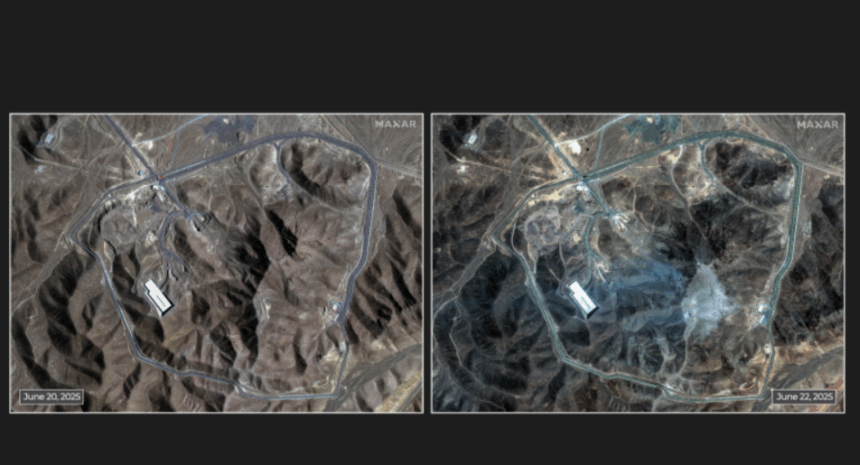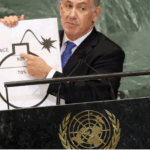In the early hours of Sunday, the world watched as the United States launched airstrikes on Iran’s Fordo, Natanz, and Isfahan nuclear facilities. B-2 stealth bombers dropped massive 30,000-pound bunker-buster bombs in what President Trump described as a “bold and brilliant” operation that had “completely obliterated” Iran’s nuclear capacity. Israeli Prime Minister Benjamin Netanyahu wasted no time in hailing the attack as historic, declaring that Trump’s decision would “change history” and deny “the world’s most dangerous regime the world’s most dangerous weapons.”
But behind the spectacle of explosions and the carefully staged press statements lies a far murkier truth—one that raises fundamental questions about what was actually accomplished, and for whom.
A Suspicious Lack of Fallout
Iranian officials, in their immediate response, confirmed that explosions had occurred at the targeted sites. But their statements took a curious turn: they insisted that no significant damage had been sustained and—more puzzling still—that there was “no substance at these three nuclear facilities that could have caused radiation.”
The International Atomic Energy Agency (IAEA), in its own assessment, confirmed no rise in off-site radiation levels, lending further weight to Iran’s claims. Satellite images obtained by international media showed surface-level blast scars but no evidence of deep, catastrophic damage that would accompany the destruction of active enrichment sites.
Adding to this, earlier this year the U.S. intelligence community concluded that Iran was not pursuing a nuclear weapon, a finding that was publicly affirmed by Director of National Intelligence Tulsi Gabbard. In testimony before Congress, Gabbard stated that Iran’s supreme leader had not revived the country’s nuclear weapons program since its halt in 2003. Although President Trump later dismissed this assessment as “wrong,” Gabbard’s testimony was consistent with the IAEA’s longstanding reports, which have found no evidence of active weaponization efforts.
Let that sink in. If the U.S. truly bombed active nuclear enrichment facilities, why was there no radiation leak? No environmental catastrophe? No evidence of the type of destruction that would follow an attack on operational nuclear sites?
This glaring inconsistency leaves us with two plausible scenarios:
First, the sites were already empty. Reports of unusual activity and satellite imagery in the days before the strike suggest that Iran may have cleared out sensitive materials—possibly after receiving advance notice from the U.S.
Second, the sites never housed weapons-grade material to begin with, reinforcing what many in the intelligence community quietly acknowledged: there was no imminent nuclear threat from Iran.
In other words, either the facilities were already emptied (with American foreknowledge), or they never housed weapons-grade materials at all—meaning there was no imminent nuclear threat, and the U.S. attack accomplished little beyond optics.
The Optics of Escalation for De-escalation
What we are witnessing is a classic case of escalation for de-escalation—a strategy where the appearance of bold military action is used not to prolong war, but to create the illusion of victory and closure.
Trump’s actions bear this out. He announced that Iran was given a two-week window to respond, shortly after dining with MAGA icon Steve Bannon. Then, following a call from Israeli Prime Minister Benjamin Netanyahu, he authorized a limited, highly choreographed strike—after informing Iran in advance.
U.S. officials framed the operation as “intentionally limited,” with no aim of regime change or prolonged engagement. Defense Secretary Pete Hegseth emphasized that this was not the beginning of an open-ended conflict. In truth, the strikes provided a public relations victory for both Trump and Netanyahu at a moment when Israel’s campaign against Iran was faltering.
For 10 days, Israel pounded Iranian targets, citing the urgent need to halt Tehran’s supposed sprint toward nuclear weapons. But as international skepticism mounted — and no concrete evidence of an imminent nuclear breakout surfaced — the justification for continued Israeli bombardment grew thin. The U.S. strike conveniently handed Israel the headline it needed: Iran’s nuclear threat destroyed.
The real goal here isn’t to topple the Iranian regime or even to destroy its nuclear program if it truly had one. That objective, long touted by Israel, appears quietly shelved. Instead, Trump is trying to create a moment of “mission accomplished,” allowing him to step back while claiming strength, and giving Netanyahu a way to de-escalate.
Netanyahu capitalized on this moment with over-the-top praise for Trump, framing the U.S. action as nothing less than historic. He called Trump’s decision to strike Iran’s nuclear facilities a “bold” act that wielded the “awesome and righteous might of the United States” and declared that it would “change history.” He went on to assert that America had done what no other country could do, and that history would remember Trump as the leader who denied the “world’s most dangerous regime the world’s most dangerous weapons.” In Netanyahu’s telling, Trump’s leadership had created a pivot in history, one that could lead the Middle East toward prosperity and peace. Echoing the familiar mantra, Netanyahu declared that “peace through strength” had been realized through Trump’s actions, emphasizing that strength must come first — and that the United States had shown “a lot of strength” that night.
This gushing tribute was more than flattery; Netanyahu can now claim success and wind down the offensive. Trump, in turn, positions himself as the strongman who acted decisively — without dragging the U.S. into deeper entanglement.







